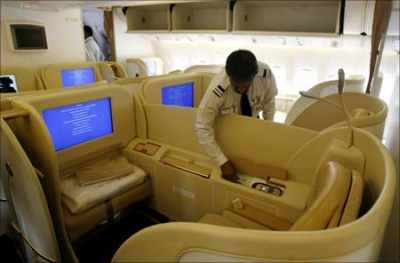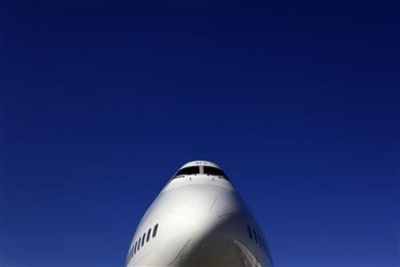Photographs: Punit Paranjpe/Reuters Mihir Mishra in New Delhi
The civil aviation ministry plans to auction air routes which connect smaller cities to boost regional connectivity.
Routes and airlines will be matched through competitive bidding.
"We plan to call an auction to select an operator for a particular route and the company that bids for lowest subsidy gets the route," said a senior civil aviation ministry official, who did not want to be identified.
"Talks are on with the planning commission, which is in favour of the proposal."
A fund, Essential Air Services Fund or EASF, will be created for paying the subsidy.
. . .
Smaller cities may find place in air map
Photographs: Reuters
"The routes to be selected will be loss-making routes connecting smaller cities with lower passenger loads and airlines are averse to operating such routes because of low traffic.
Basically, the plan is to provide connectivity to these cities through smaller planes," the official said.
The airports at Delhi and Mumbai account for 70 per cent of the total aviation market of the country.
Both these airports are privately-owned.
The government categorises routes into three categories in a bid to ensure airlines fly all routes.
The first category consists of 12 that include the key routes which connect larger cities.
. . .
Smaller cities may find place in air map
Photographs: Toby Melville/Reuters
The second includes flights to the North East, Jammu and Kashmir, Andaman and Nicobar and Lakshadweep.
The other destinations are covered under category three.
In terms of passenger carriage, over 50 per cent of domestic passenger traffic is in category I routes, around 10 per cent in category II and around 40 per cent in category III routes.
According to the rules, an airline has to operate 10 per cent of total flights operating in category I routes in category II routes and 50 per cent of its total flights in Category I routes on on category III routes.
. . .
Smaller cities may find place in air map
Photographs: Stefan Wermuth/Reuters
Good for Airports Authority
The move to encourage airlines to fly regional routes will also give a boost to the Airports Authority of India, which operates airports in the smaller cities of the country.
Of the 128 airports of the Airports Authority of India, 87 are operational.
Only 14 are profit making.
Airlines welcome the move saying that it will be of great help.
"There are various regions in the that require air connectivity and an impetus like this from the government will help us develop these routes because connectivity creates demand.
As it is the airlines are not in good financial health and cannot afford to venture new routes," said a low-cost airline executive.
. . .
Smaller cities may find place in air map
As of now, only SpiceJet has started flights to provide regional connectivity in the southern part of the country with small aircraft which do not have to pay any parking and landing charges and gets fuel at a discounted sales tax of 4 per cent, compared to an average sales tax of 24 per cent for bigger planes.
Routes in the north-east, though termed Category II, a slightly less-difficult category, continue to be poorly serviced.
The government is looking at increasing air connectivity in these parts by building airstrips.
During the 11th Plan period (2007-12), the government had announced to build three greenfield airports -- one each at Pakyong in Sikkim, Itanagar in Arunachal Pradesh, and Chiethu in Nagaland, which are in their construction phase.







article